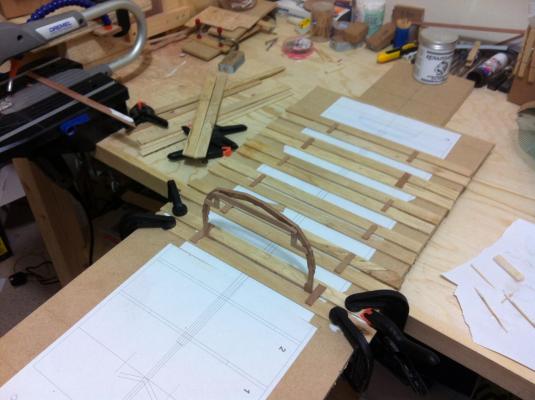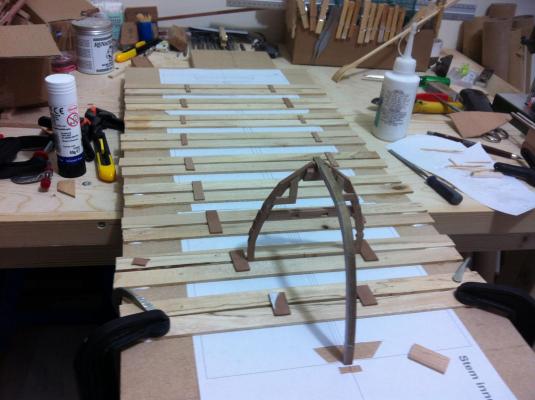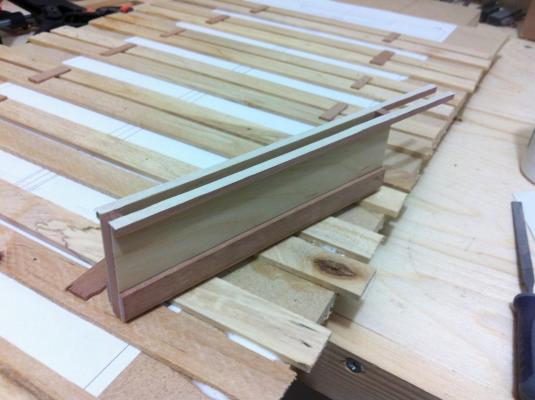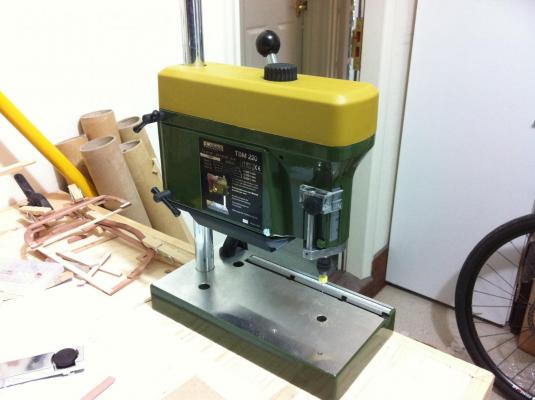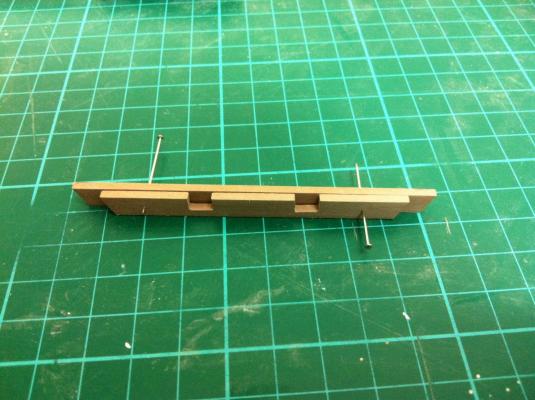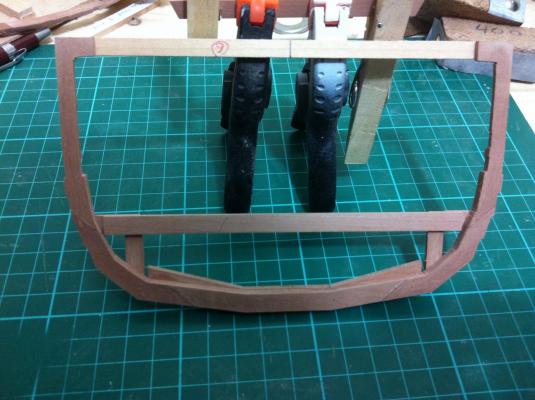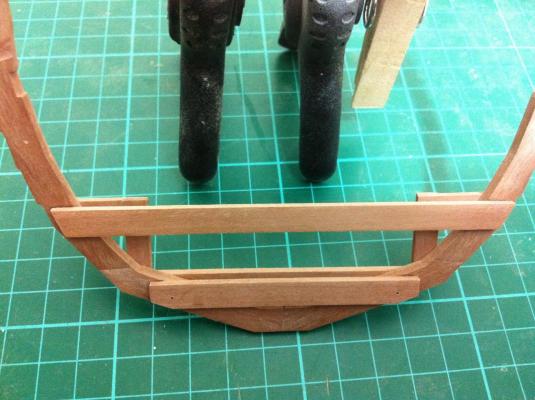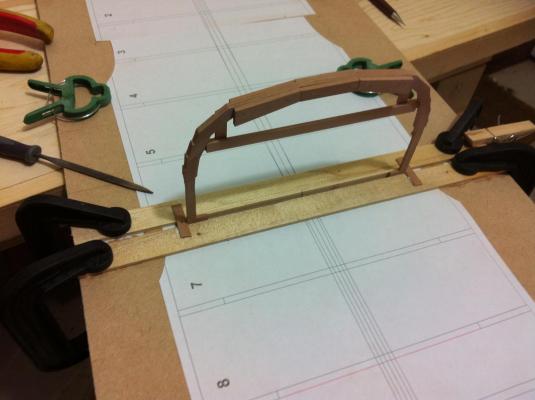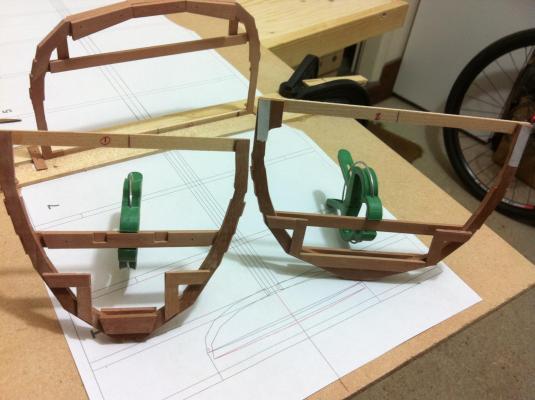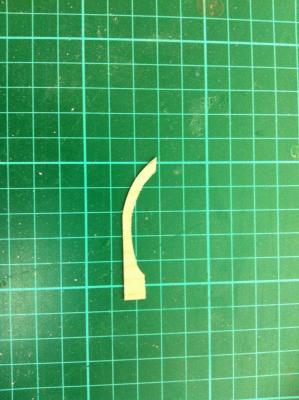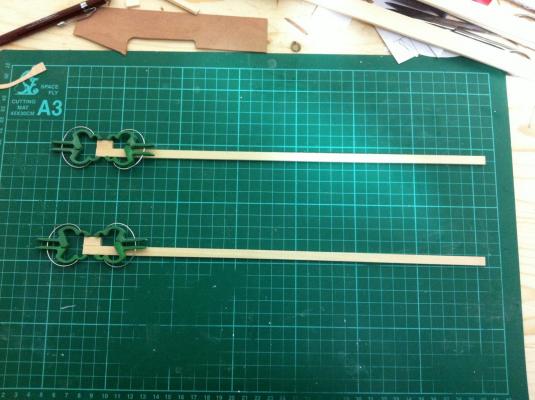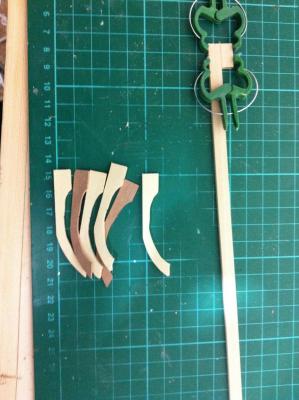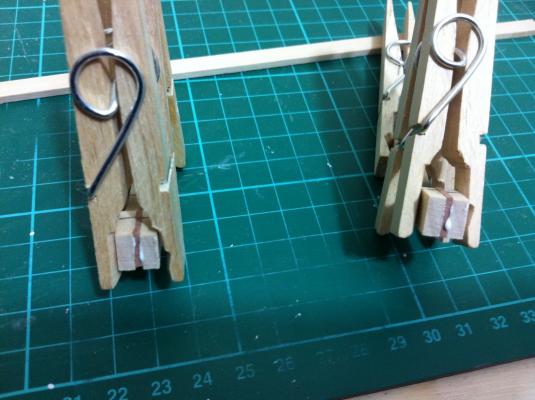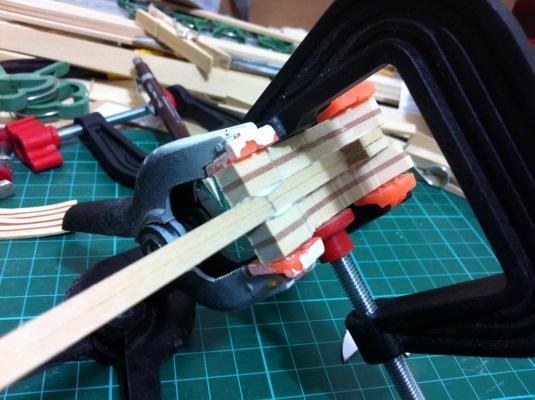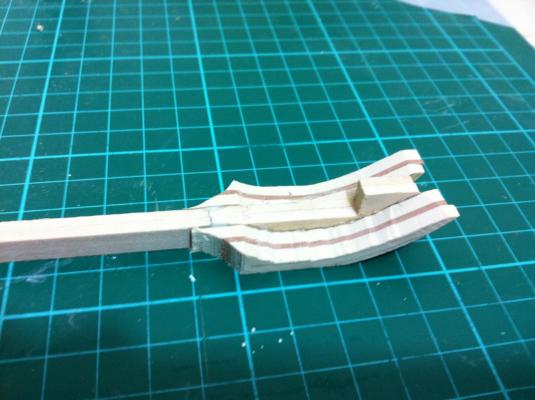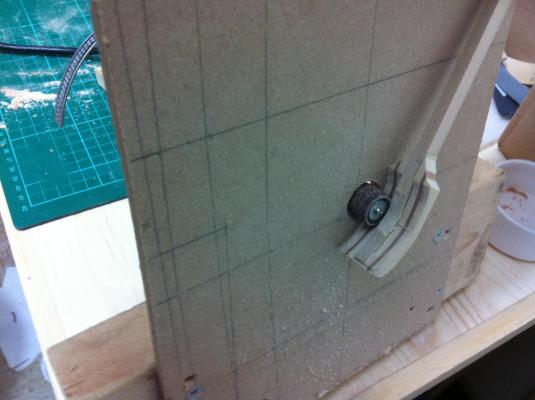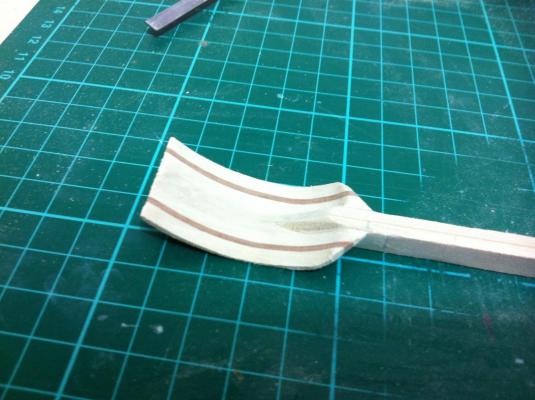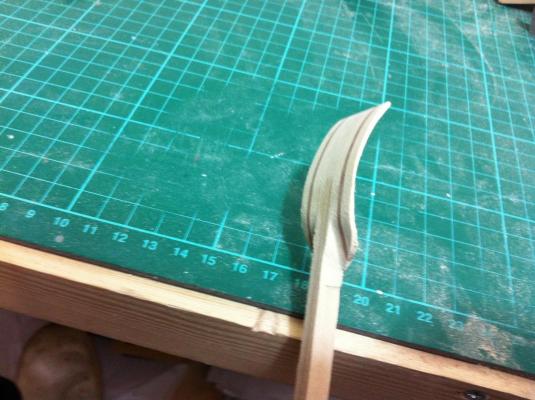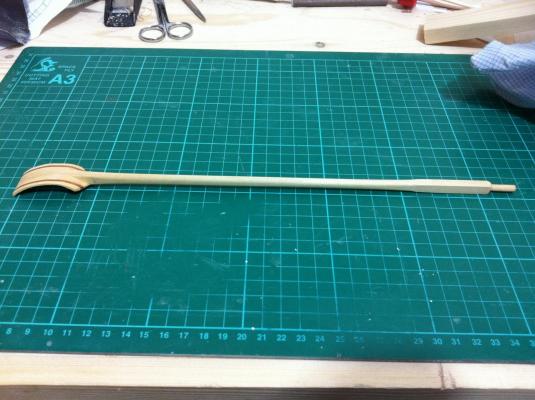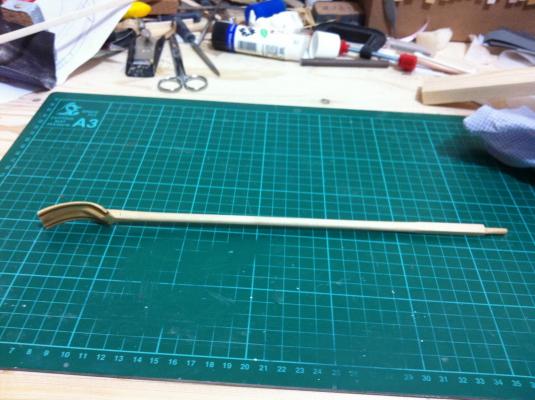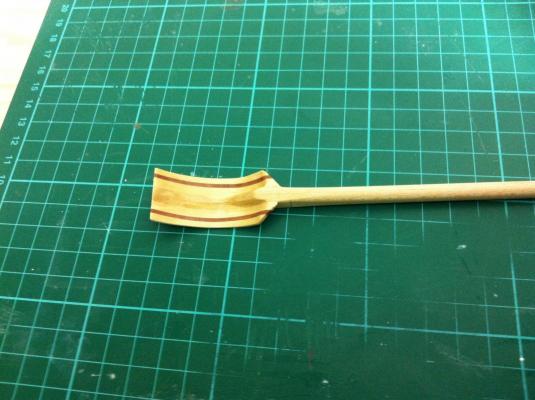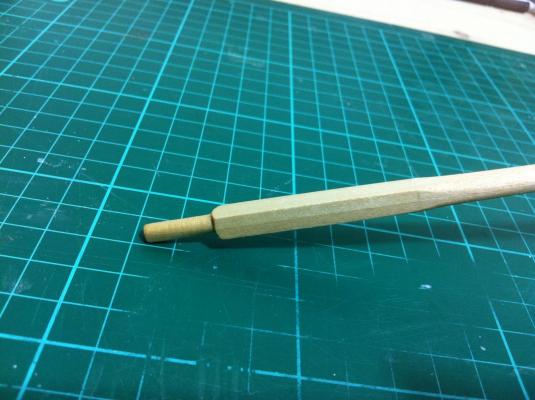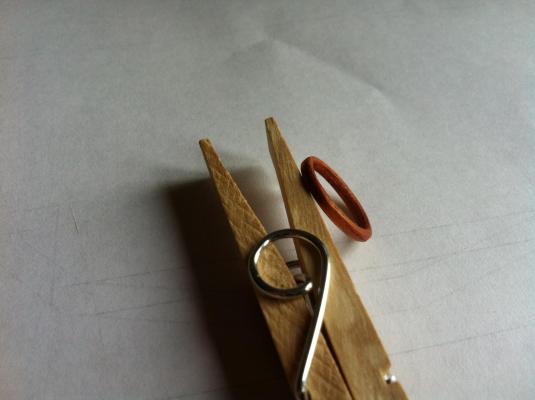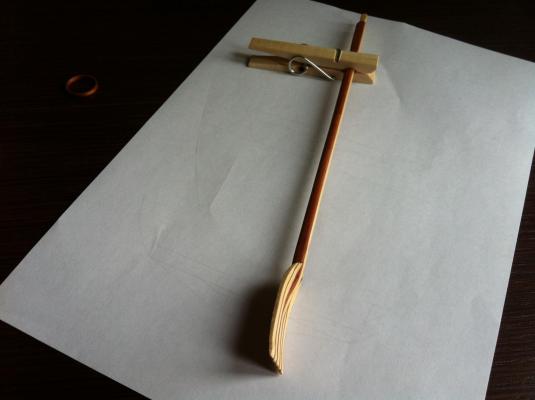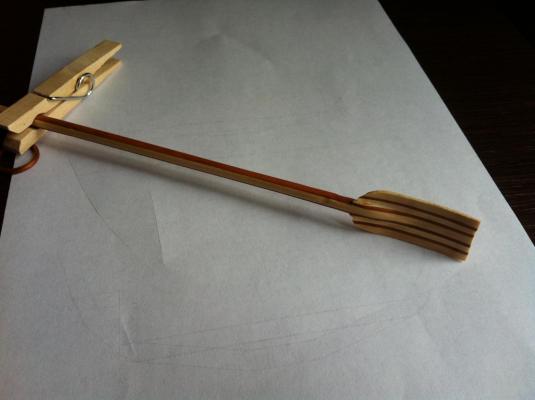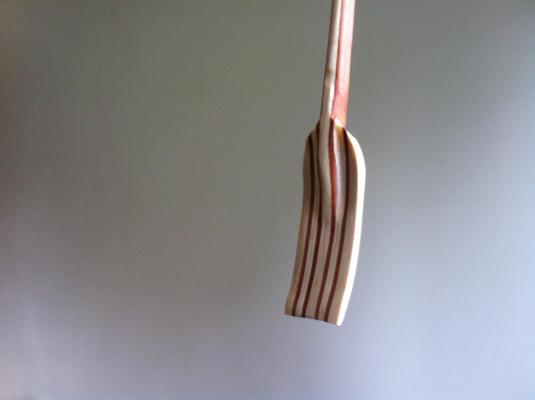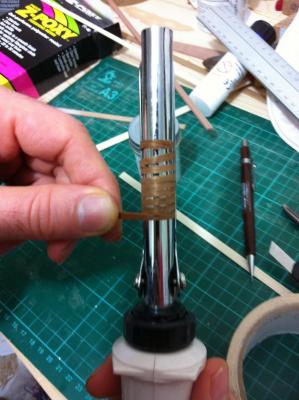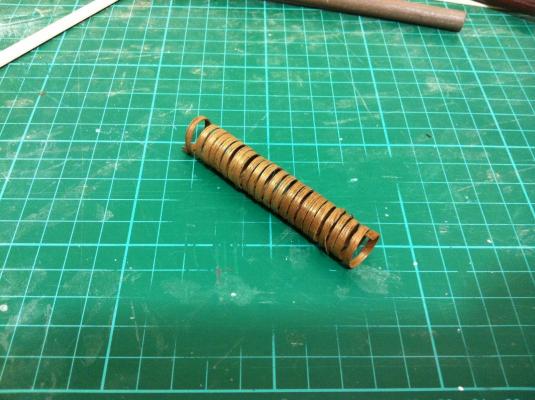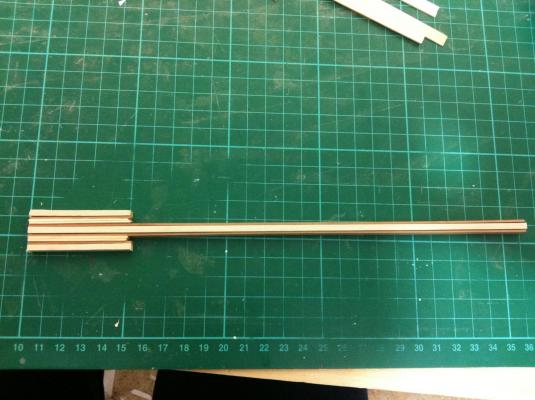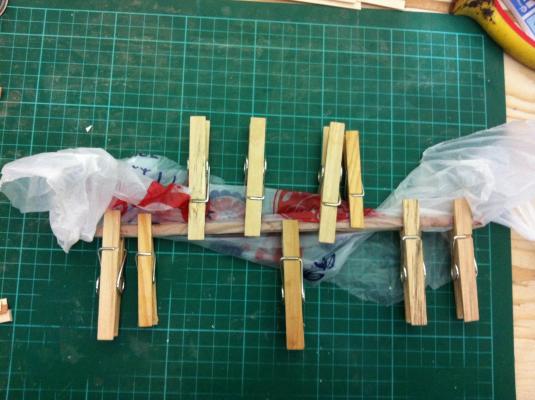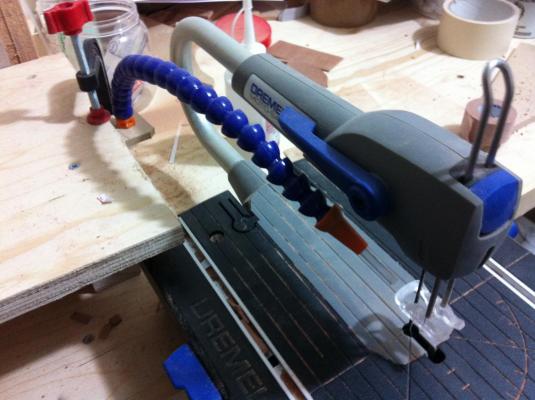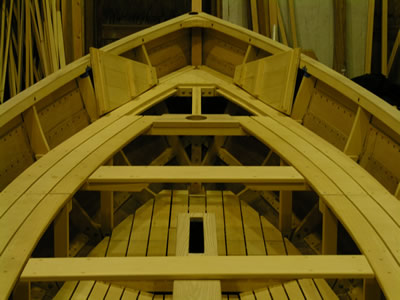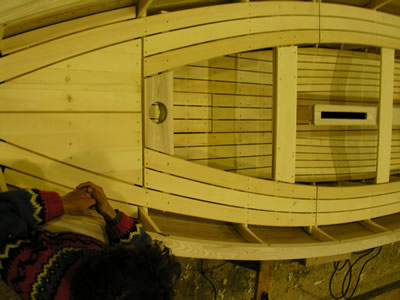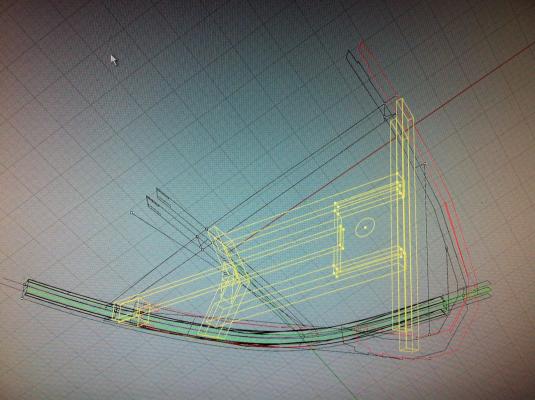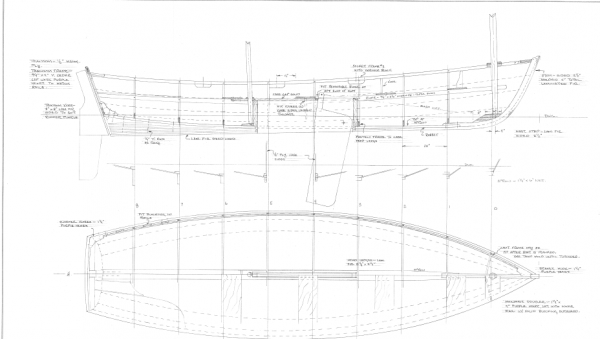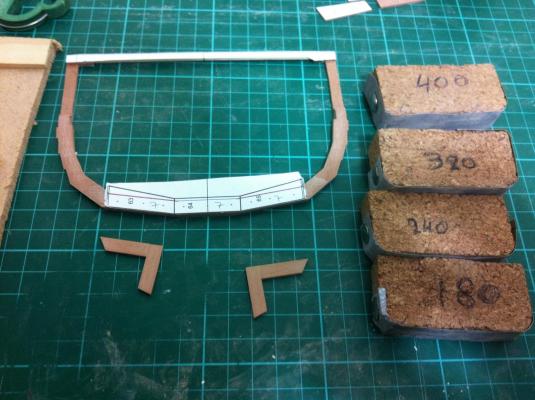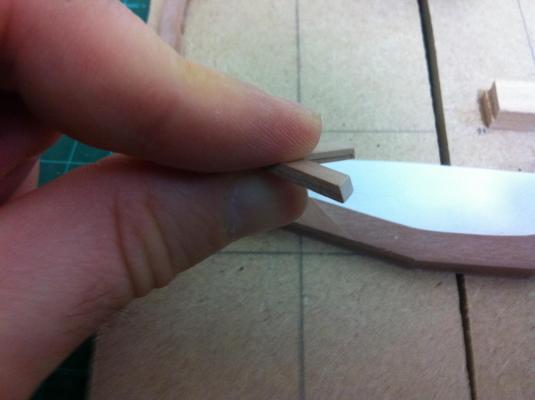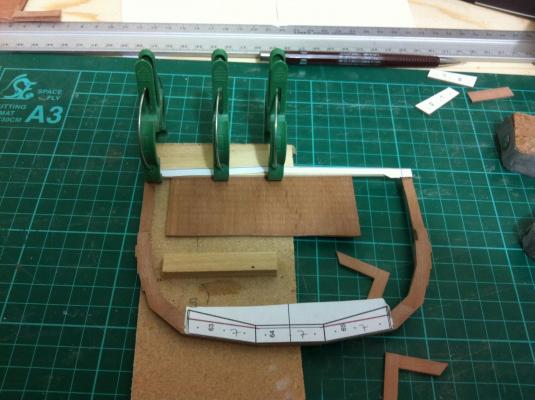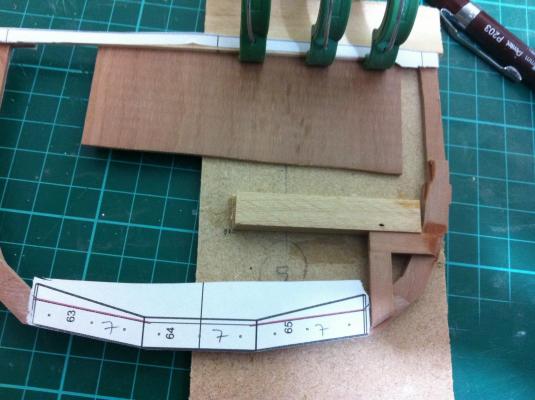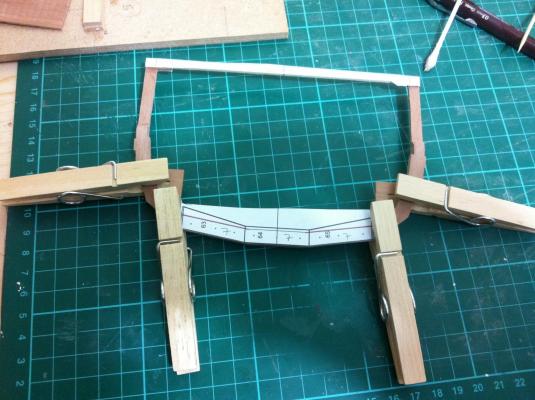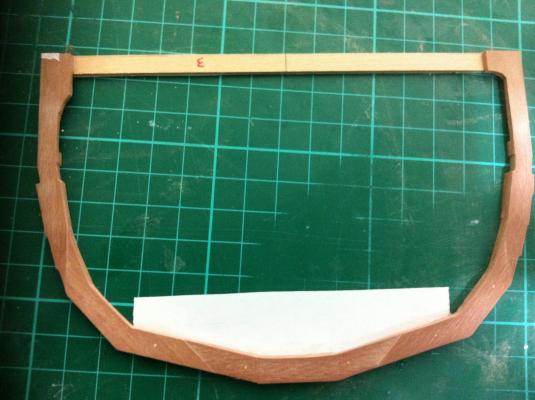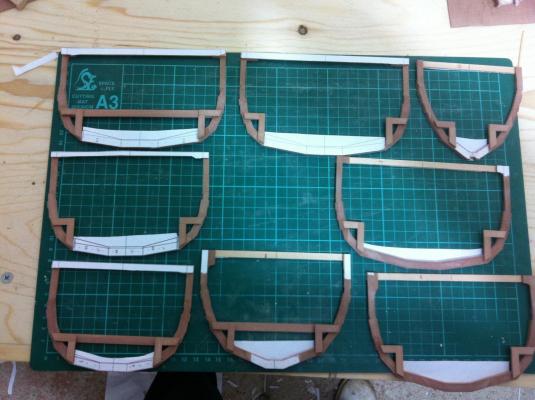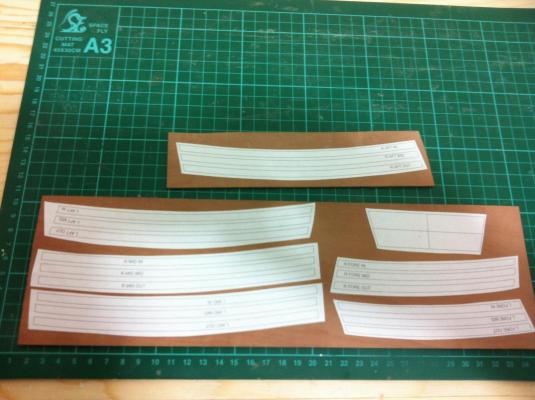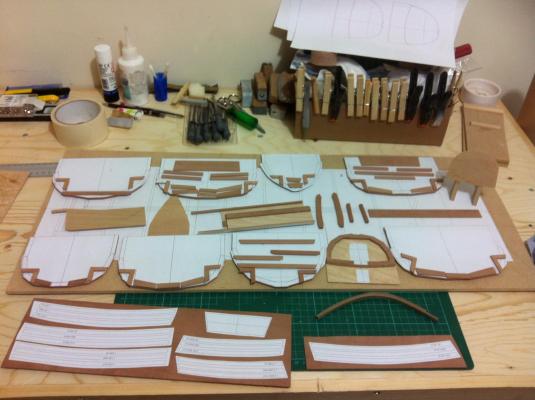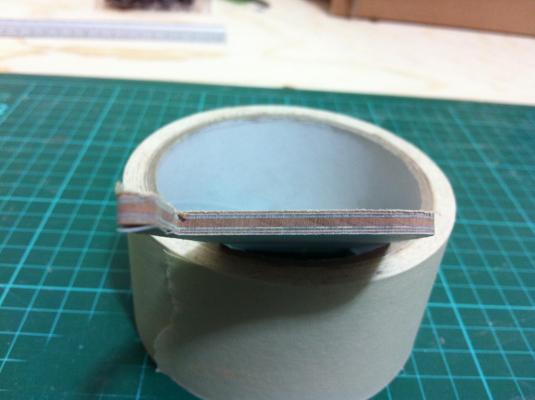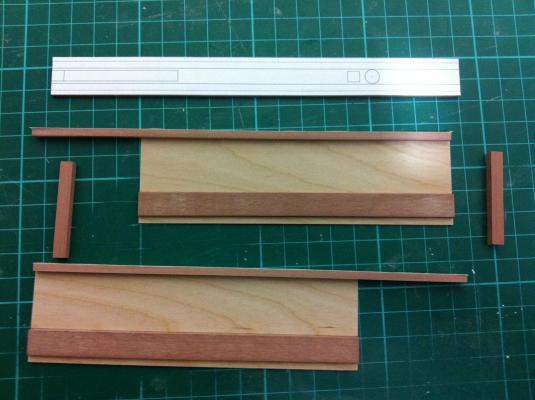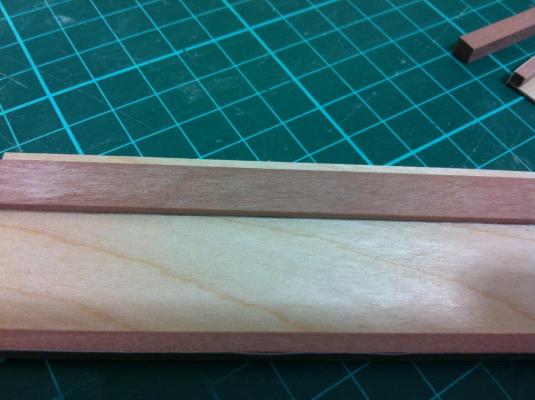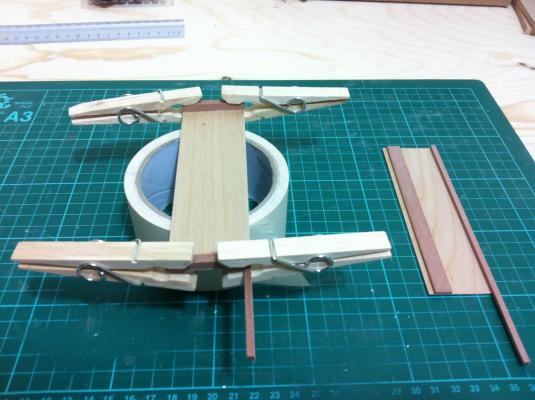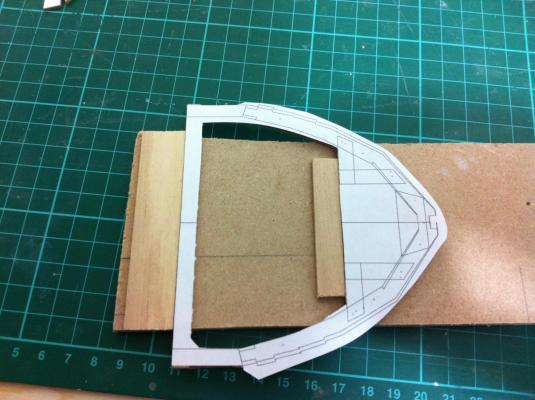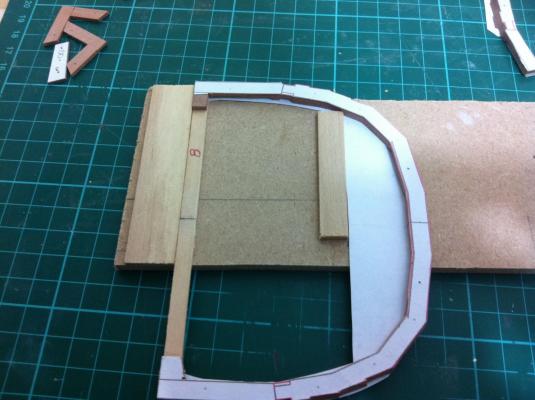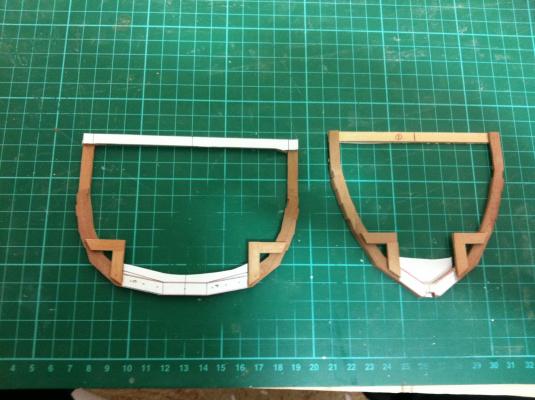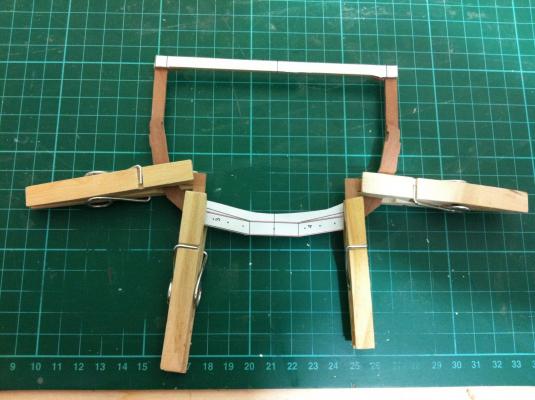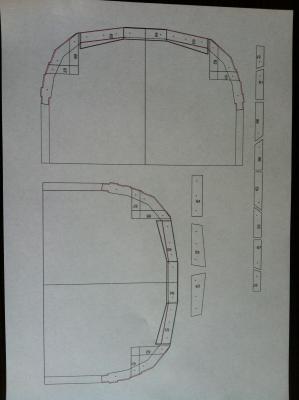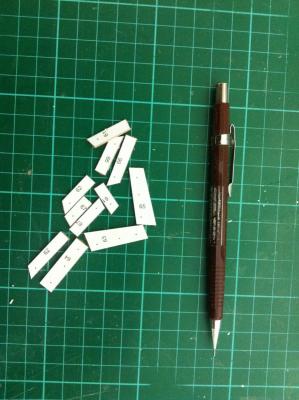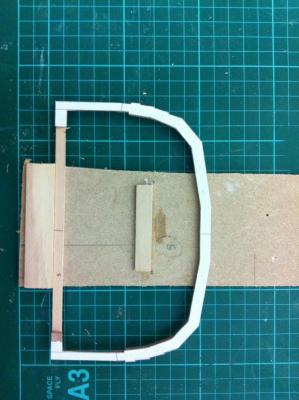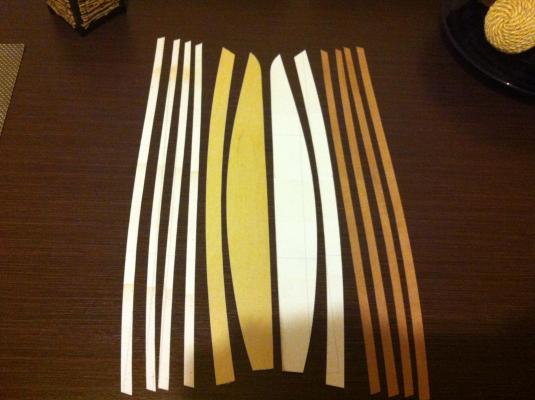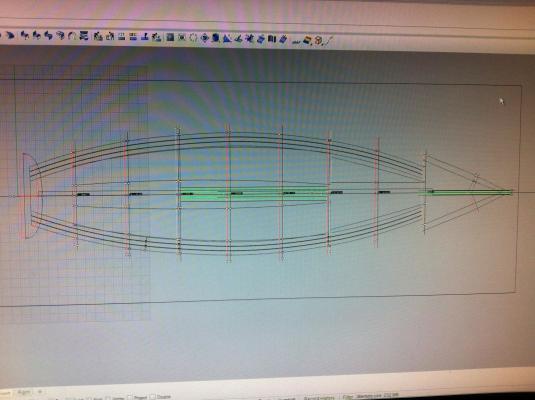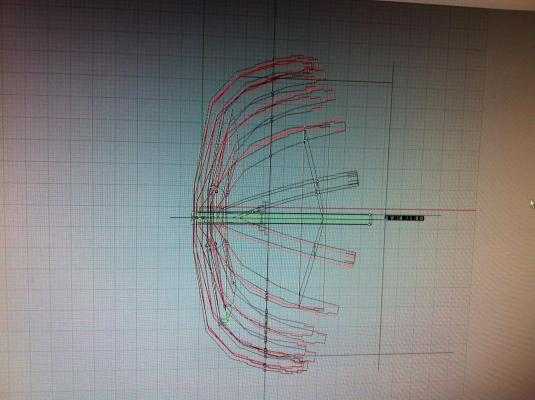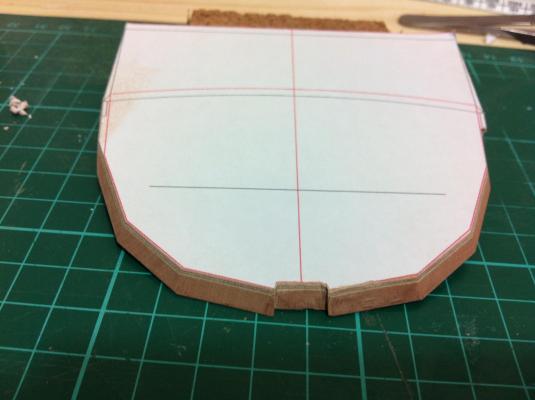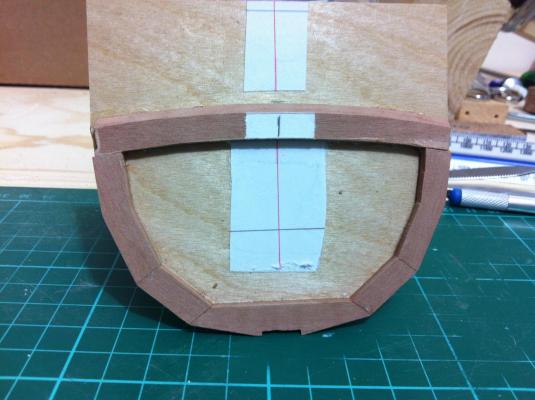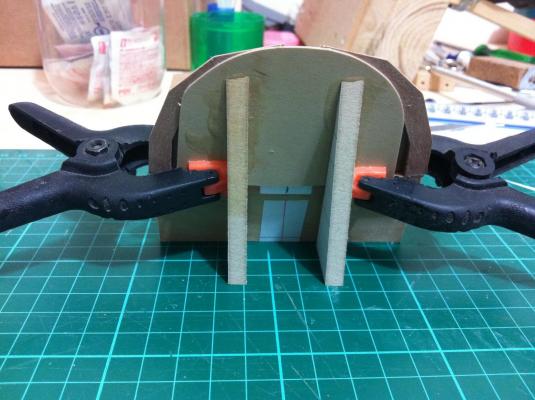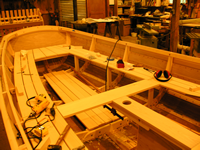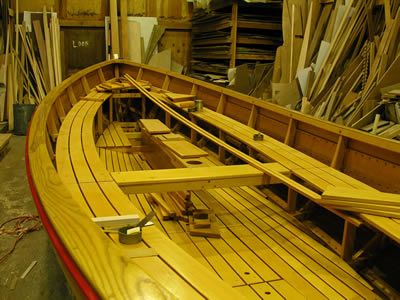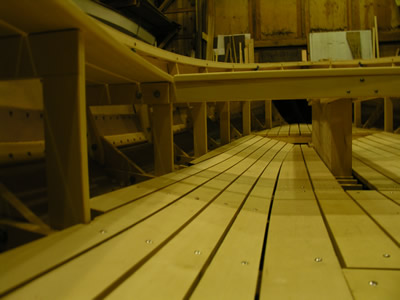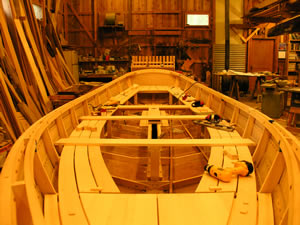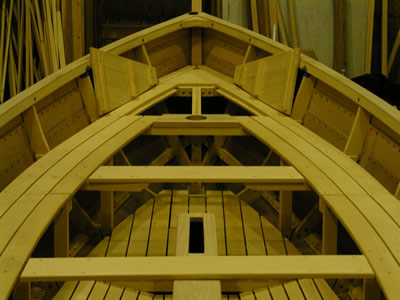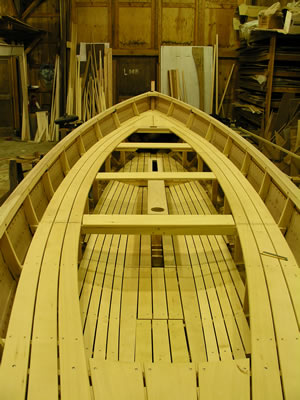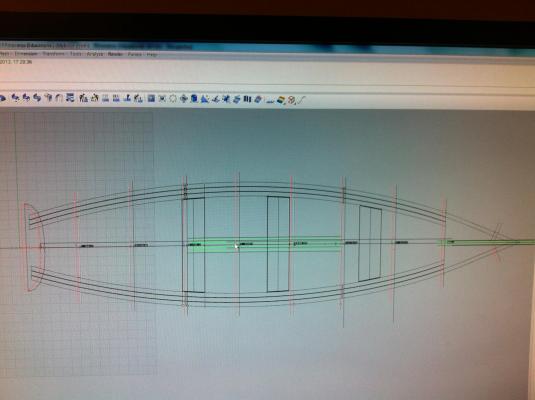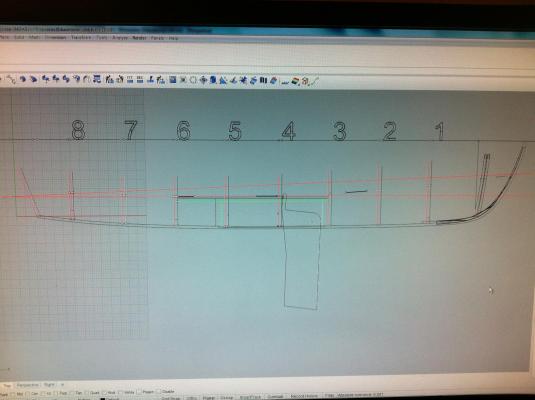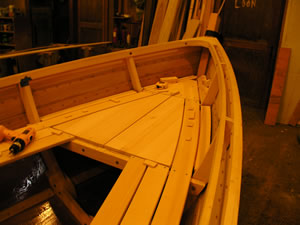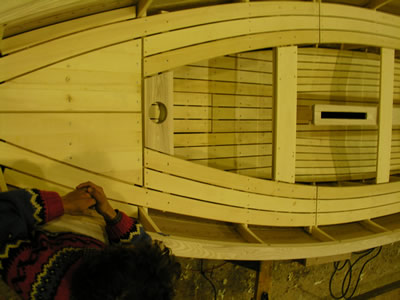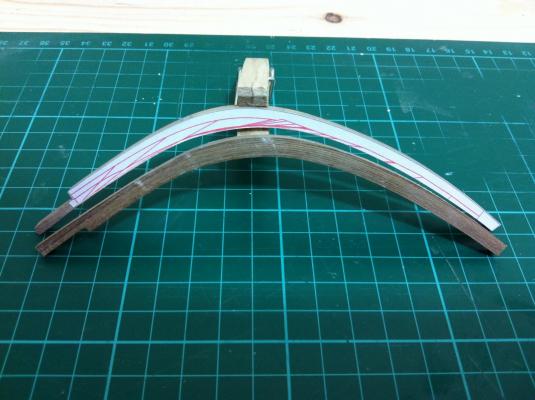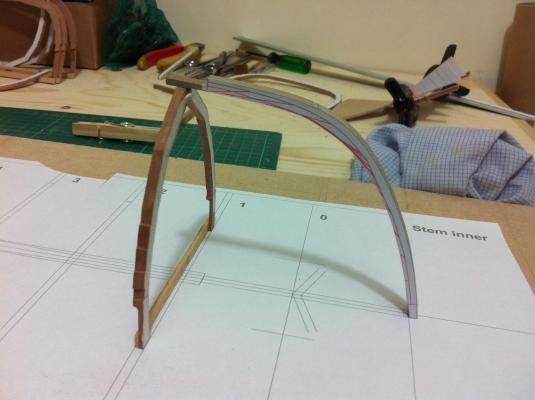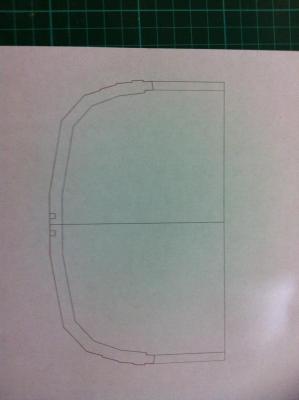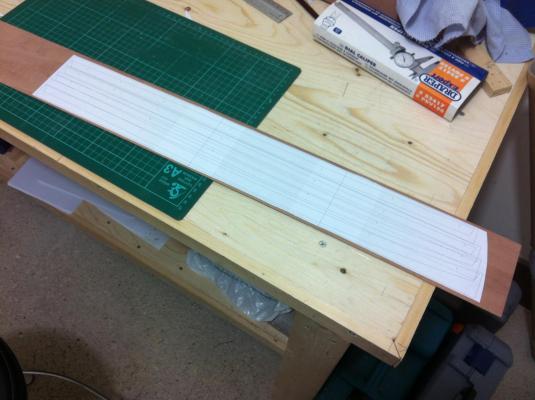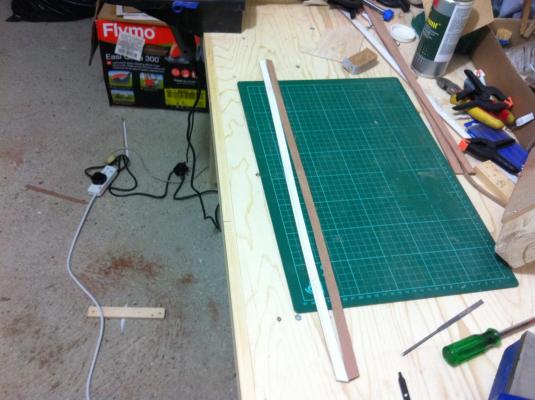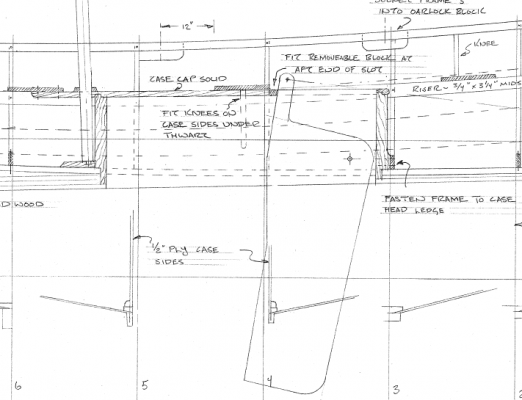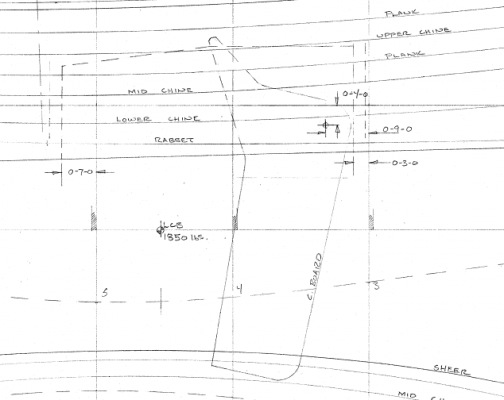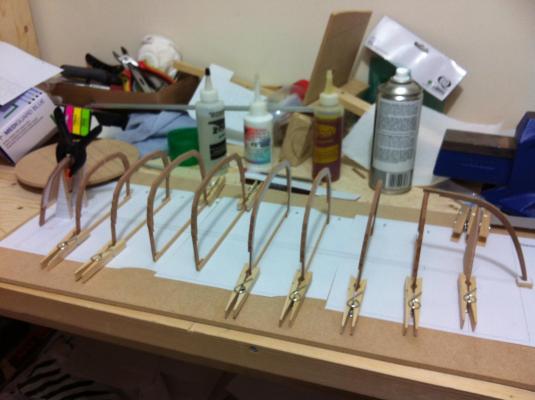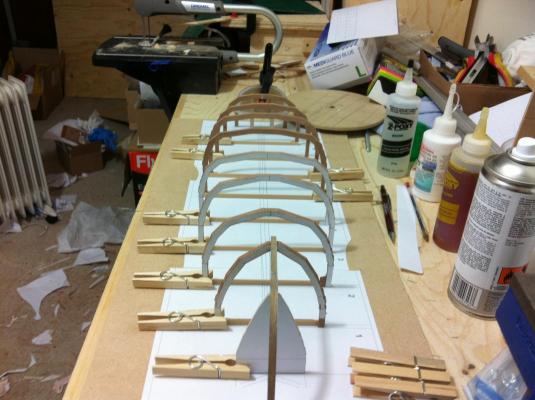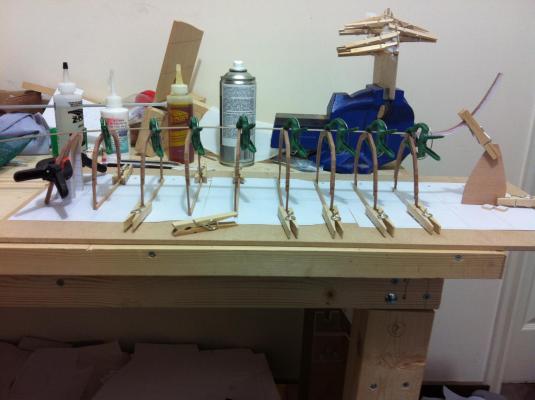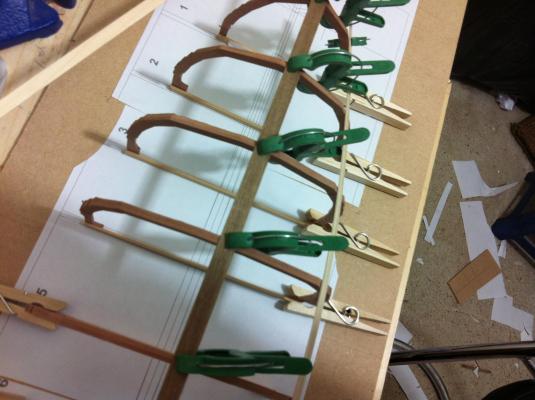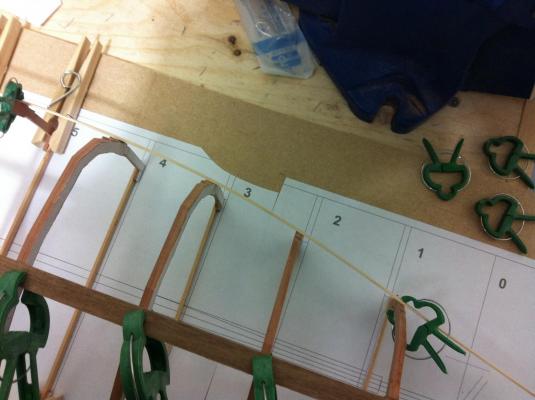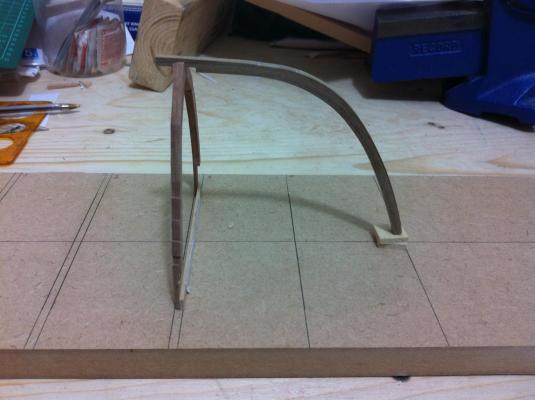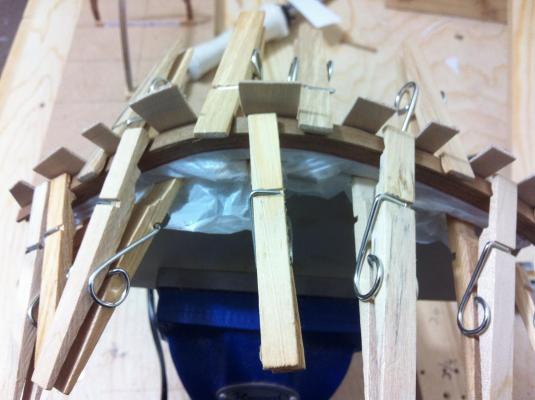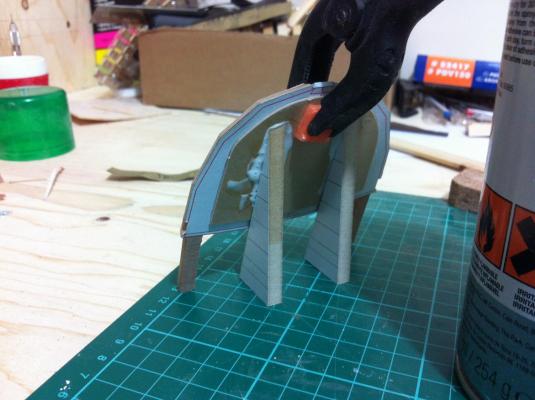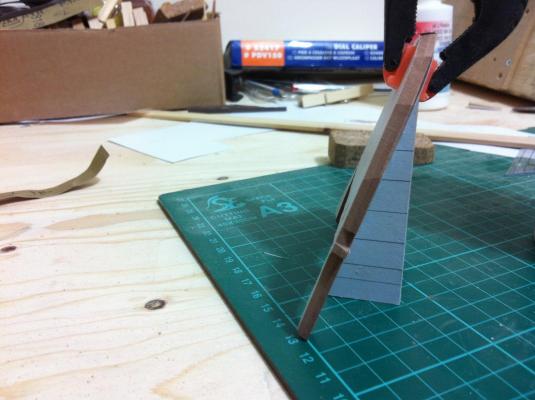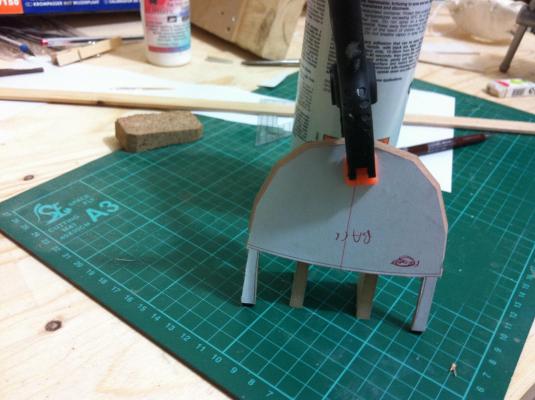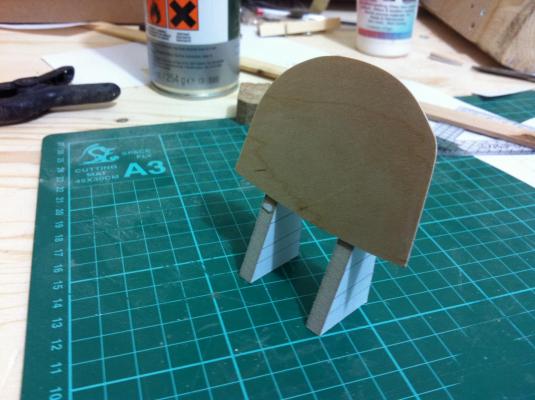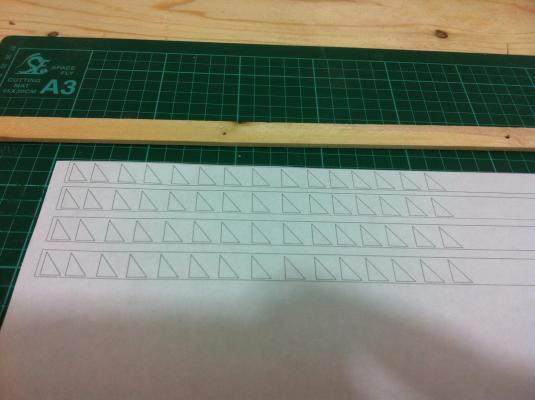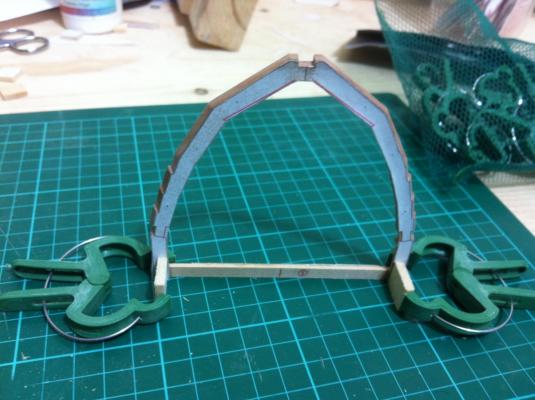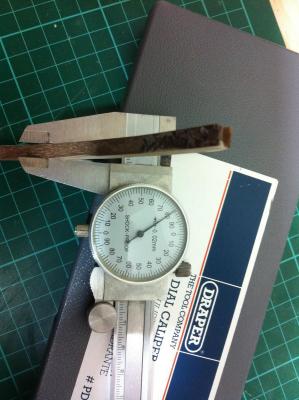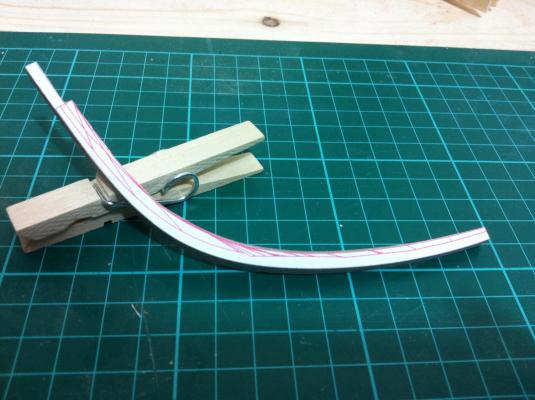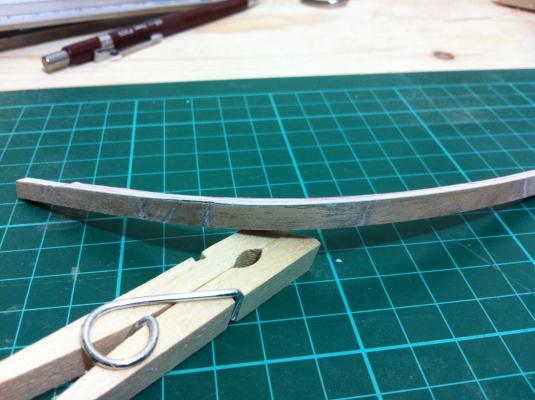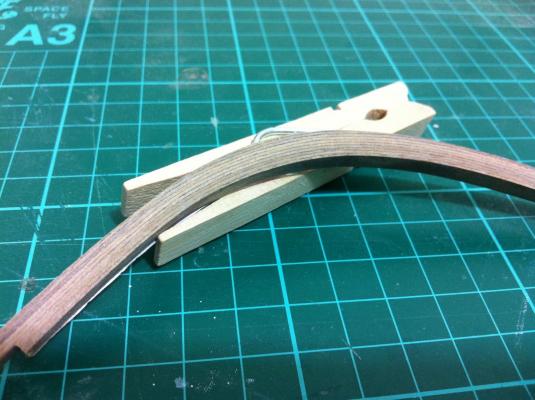-
Posts
1,600 -
Joined
-
Last visited
Content Type
Profiles
Forums
Gallery
Events
Everything posted by vaddoc
-
The jig is progressing well. I plan to add later on longitudinal beams on each side at a height from the baseline and cross beams, 2 for each frame. It should be reasonably steady. I need also to secure the stem and fine tune the bevel of the temporary mold at station 0 that later on will be replaced by the cant frames. The centerboard case is also progressing and coming out very nice, I think it will be the best part of the boat! I am certain the next big difficulty will be bevelling the apron and the stem to accept the bottom plywood panel which is essentially the garboard plank. The apron will have a thickness of 3 mm so it cannot be beveled like the keel of large boats. I also plan to laminate a false stem.
- 253 replies
-
- ketkch
- gaff-rigged
-
(and 1 more)
Tagged with:
-
Grateful for the support Patrick! I agree with you, curved blade oars are nicer and probably the next ones will be easier to make but I need to find a way to ensure consistency. I should also try a flat one and see how it looks. Anyway, I will change focus for now and allow time for ideas to ripen. My drill is here! It is really well made, spins very true, is quiet and easy to use. Highly recommended. I finished glueing all the beams that are attached to the frames and sanded everything down to 400 grit I planned to apply wax to all surfaces prior to assembly but it did not work very well, the surfaces are very complex and there is a risk to contaminate the surfaces that later on components will be glued. Also, sanding had produced some fine whitish streaks on the wood that I thought the wax would cover. This did not happen though. I am not sure what the cause is, I suspect these are scratches due to not changing the sand paper as often as I should. They are not a huge problem though, it still looks good. Another problem to sleep on. The time has come to laminate the apron and for this all frames need to be erected. So I need to make some sort of jig. I do not have the equipment to produce the jigs I see the master modellers use so I have to improvise. I have a lot of this nice wood which is really a fence bought from poundland. I did a bit of Zen and I think I can make the jig work. Another picture of frames No 1 and 2. I am happy with the alignment of the components although I will not really know until the final assembly
- 253 replies
-
- ketkch
- gaff-rigged
-
(and 1 more)
Tagged with:
-
I had another go today making the oars. I watched a video on you tube of a company making high end oars and copied their method. I also found out the maths behind the length oars should have and for this boat its 32 cm, much longer than the first attempt. First I made a rough pattern of the curve of the blade from scrap plywood. Then I glued a small piece at the end of the long pieces that will later on be glued together. This because the end of the curve goes beyond the width of the strips. I used lime for two reasons, because it sands easily and also I have lots of it. I then made some more pieces from the pattern. The darker ones are pear, but these are cut at an angle to the grain so that when all are laminated it will provide some strength against breaking. All are glued together And glued again This is how it looks before the sanding spree The corners near the shaft where cut off and then carefully the oar was sanded into shape. The improvised table for the Dremel was very useful. The blade was shaped first and then the shaft. This is how the oar came out, it certainly looks better. It took half a day to make one oar and the chances of all 6 coming out reasonably alike I think are slim. Might be better to go for flat ones which should be easier to make.
- 253 replies
-
- ketkch
- gaff-rigged
-
(and 1 more)
Tagged with:
-
I experimented with the hoops and oars (good title for a boating magazine). The hoop came out alright, although mahogany is a poor choice I think as it splinters a lot. I used it just because I had a few left over strips but I might order thin strips of another wood. The hoop on the photo has been sanded to 400 grit and had a coat of Tung oil. The oar was much more challenging. The end result is horrible but I think that it could be done with a lot of patience, planning and attention to detail.
- 253 replies
-
- ketkch
- gaff-rigged
-
(and 1 more)
Tagged with:
-
Another task is the construction of the mast hoops. I had some 0.5 mm mahogany strips, I cut them lengthwise and used the hair thingy. I am thinking that gluing 2 or 3 loops together should produce a nice hoop.
- 253 replies
-
- ketkch
- gaff-rigged
-
(and 1 more)
Tagged with:
-
Gary, I would like my CAD drawings to be put to good use rather than stay buried in a hard drive but that's for later, I would like to see first the project completed which will validate their accuracy. Back to the boat, work has stopped as I am waiting for the replacement drill press. A lot of drilling is necessary at this stage and I resisted temptation to use the hand drill, the accuracy of the machine will be far superior. A side project will be the making of oars and this is a project I was actually looking forward to. I am sure there are some guidelines regarding length etc but a quick search on the net did not produce a lot so I made an uneducated guess. I think a curved blade configuration with laminated maple and walnut would be nice, finished with Tung oil and Renaissance wax. I laminated a few pieces for oar No 1 (test oar if it goes wrong).
- 253 replies
-
- ketkch
- gaff-rigged
-
(and 1 more)
Tagged with:
-
There are many CAD programs Gary, I use Rhino 5 because this is the one I had access to. I think they all are similar but be advised they can be very expensive, Rhino I think might run close to $1000. You also might need someone to get you started ( I had a friend who is an architect) and then on you ll figure things out yourself. I also tried some of the free ones on the net but did not like them. Regarding the blower for the saw, I now attached a lathe hose and the whole thing works very well.
- 253 replies
-
- ketkch
- gaff-rigged
-
(and 1 more)
Tagged with:
-
Today was a challenging day. The drill press arrived but was faulty so had to go back. The proxxon unit though looks very solid and ideal for modelling. I really liked it. Back to the boat, I was working on the deck assembly and realised a big problem. As it stands the main mast has very little support. Tad in his plans positions the main mast at station 0, where the cant frames are. This position looks to me too much forward and indeed the US team positioned the mast at frame 1. However, studying the photos it seems they used very thin profile wood for the beams and also secured one side of the mast partner to the side benches. They obviously knew what they were doing but still I wonder how the mast can cope. Since I changed the thwart arrangement I cannot copy their design. I like the position of the main mast at frame 1 though. So back to the computer to arrange the beams for supporting the mast and the deck. The main problem are the cant frames and it was incredibly difficult to find an arrangement that would actually work in a full scale boat. Also, the deck is not horizontal but has a slope which added to the complexity. All beams had to be notched to accept one another. I am very happy with the result, it looks super strong and I am sure it would be fine in a real boat. Building to these plans of course is another issue.
- 253 replies
-
- ketkch
- gaff-rigged
-
(and 1 more)
Tagged with:
-
It works brilliantly Garry, it has become my main tool. Still on the original 120 grit paper!
- 253 replies
-
- ketkch
- gaff-rigged
-
(and 1 more)
Tagged with:
-
.thumb.jpg.6fd4c1b78768bb3efd745ab810936005.jpg)
Renaissance wax for finish
vaddoc replied to vaddoc's topic in Painting, finishing and weathering products and techniques
I think you are right Remco, turpentine should work better but compared to low odour Mineral oil which in essence is odour free it is very unpleasant to use. Either way, just rubbing the wax with cloth I found works brilliantly. Pure tung oil is great, really brings out the beauty of the wood. I think though it will darken the swiss pear I am currently using. How do you buff the waxed surface?- 11 replies
-
Your support is much appreciated Patrick, especially as time is running out...there is a little one due in 6 weeks and undoubtedly work will slow down to a halt. I will present briefly the process of glueing the knees. First everything is sanded to 400 grit.The paper pattern is used only for the lateral adjustment as the height will be set by the jig. I could not resist bevelling the ends of the knees although I think they might not be visible The contact areas are marked on both sides to apply glue appropriately. The green clamps are used in gardening, I find them very useful and costed me £1 for a pack of 20! Excess glue is carefully cleaned with water. The lap joints in the frames came out nice, the frame is only sanded, when the wax is applied it will show much less I think All knees and some of the beams supporting the thwarts are ready. I have some 1 mm walnut dowel which I am thinking of using as nails or I might save it for the planking and use toothpicks instead. Before I do any more work I really need the drill press, until it arrives I will work on the floor and deck arrangements.
- 253 replies
-
- ketkch
- gaff-rigged
-
(and 1 more)
Tagged with:
-
The work is progressing well and many components are ready to be installed. I still need to design on CAD the deck arrangement with the mast partner and beams, the floor arrangement and aft thwart at the transom. The planks for the benches are ready to be cut, I am thinking of improvising some short of sanding jig which will have the shape of the benches to assist in sanding the inside part of the planks. This is an overview of all the components already prepared, not including the planks I also made the centerboard, it should be made of steel but I think a common alternative is a laminate of wood core sandwiched by plywood and fiberglassed over. This is what I did minus the fiberglass. It still needs some sanding and painting. It came out super stiff. I also did some work on the centerboard case which is coming out really nice. I try to make sure everything is sanded before assembly and that excess glue is cleaned immediately. All joints so far are very clean. I also glued the knees for the frames 1 & 8 using the jig and things look reasonably aligned. It is not a really solid process but it works so I am sticking to it for now. Everything is sanded before assembly and since I will be using Renaissance wax no other preparation is needed. I have ordered the Proxxon drill press which will be I think extremely useful. If I had it earlier, assembly would be much easier and accurate. Lesson learned.
- 253 replies
-
- ketkch
- gaff-rigged
-
(and 1 more)
Tagged with:
-
.thumb.jpg.6fd4c1b78768bb3efd745ab810936005.jpg)
Renaissance wax for finish
vaddoc replied to vaddoc's topic in Painting, finishing and weathering products and techniques
Do you polish it somehow Brian? My test pieces show some streaks when held against the light, not too much though. I tested buffing with a buffing wheel and the Dremmel but it does not work great. Polishing with the hand does not feel the same as with other waxes as this dries very hard.- 11 replies
-
Progress has been slow as the built is becoming more complex. I have decided to add all the knees and the beams that support the side benches, thwarts and deck to the frames before assembling the hull. In the full size boat this would be done after planking but I think it would be very difficult. I will also need to make and add the centerboard case and all the supports for the floor. This is massive work and it is a bit strange, months of work and nothing to show but a glimpse of the hull lines when test fitting the frames! I think this is a case when you need to treat every small component as a model of it self. Of course all these will need to be finished prior to installing. I am sold on the Renaissance wax which excited expectations in my testing. Back to the computer then. The next photo shows the template for frame No 7. The knees will be made full lap which is a bit of a challenge as the pieces are becoming too small. All done. The paper template is glued to the back of the frame However, when I add the knees and floor supports I will not use the paper template. I have made a simple jig so that all knees will be positioned at the same height without tolerances I realised that I need a drill press, I am surprised how widely inaccurate hand drilling is, at least for me. I also keep bending the drills. I got clearance from the wife and I am thinking of getting the Proxxon 28128 TBM 220. Any thoughts on this?
- 253 replies
-
- ketkch
- gaff-rigged
-
(and 1 more)
Tagged with:
-
.thumb.jpg.6fd4c1b78768bb3efd745ab810936005.jpg)
Renaissance wax for finish
vaddoc replied to vaddoc's topic in Painting, finishing and weathering products and techniques
An update on glueing, I can confirm that neither super glue nor PVA work on Waxed surface. The pieces separated with very little force. I tried a second piece which I lightly sanded first with 240 grit. Again, CA glue did not create a good bond but PVA worked fine producing a bond stronger than the wood. It seems that at least on pear wood and probably all hardwoods renaissance wax does not penetrate too deep and can be easily sanded off. The smell takes 24 hours to completely disappear. I suspect the boat in the meantime will be a bit flammable. I don't think there is any point testing paint over the wax, I am sure in this case sanding plus primer would be needed.- 11 replies
-
.thumb.jpg.6fd4c1b78768bb3efd745ab810936005.jpg)
Renaissance wax for finish
vaddoc replied to vaddoc's topic in Painting, finishing and weathering products and techniques
I guess that there is not much experience with this. Anyway, I did some tests and I must say I like it very much. Mineral spirits can dilute the wax but not well. I mixed some wax with a generous quantity of MS but even after much shaking there were chunks of wax still floating. I applied the mixture to wood sanded to 400 grit and when dry it showed white streaks. However a coat of wax with lint free cloth produced good results. I applied 3 coats of wax to two pieces of wood, one with sanding sealer and one without, both sanded to 400 grit. The results were almost identical but the one without sealer was much smoother. The wax does not alter the colour at all and dries as a very hard, very smooth film. The wax is very easy to apply, needs tiny quantities and dries almost instantly. It does have a rather strong unpleasant smell but this does not last long. Buffing with a rotary tool brings on some shine but I think that this is not necessary. Overall I think this is a brilliant finishing option and I will most likely use it in my current built. I will test as well how it responds to painting and glueing.- 11 replies
-
Hi all, I am thinking of using Renaissance wax for finish. I will probably be painting the exterior of my boat but leave the interior unpainted. The reasons for considering wax is that it does not raise the grain, further coats can be applied as needed and I avoid the difficulties of varnish (waiting to cure, brushmarks, dust etc). Previously I also used pure Tung oil which is very nice but takes days to harden. I am thinking of sanding to 400 grit and then just apply the wax and buff. Of course I will do a bit of testing first on scrap wood. I would be very interested for your comments. 1. Is there any reason not to use wax? 2. Should I apply the wax as is or dilute with mineral spirits, apply and leave to dry? 3. If glueing or painting is later needed, will it be possible? 4. What would happen if I first use sanding sealer and then apply the wax? Would this make easier to remove the wax if needed?
- 11 replies
-
Yambo this is very interesting, I had not previously appreciated the degree of freedom one has when building from plans. But to deviate from the plans certainly takes a lot of skill and experience. I guess you built the model before the actual boat to better understand the building process, I had read that this is a good idea but only now I appreciate this. If I was building the full scale boat I would have gone bankrupt by now! I was very lucky to find these photos Bob, they really are very helpful and show the beauty of boatbuilding. I finished the No7 frame and also finished all the planks. The curved segments were sanded with the disc sander within seconds but the concave ones were tricky. The improvised router table worked well. Following Yambo's advise I decided on the layout of the interior. Knees, a small deck with hatches, almost identical but not quite to the boat in the internet photos. The floor, benches and deck are half ready. I also was not happy with my transom. It made it solid instead of framed plywood but I like the original design better so I redid it and it looks good! I will cut the excess plywood ofter planking. In the last picture the Transom is secured to the jig. Has anyone tried the beeswax approach for finishing?
- 253 replies
-
- ketkch
- gaff-rigged
-
(and 1 more)
Tagged with:
-
I have not posted for some time but I have not been idle. I realised that although the frames, stem, planks and bevels were dealt with, I still had no idea of how to arrange the thwarts or the floor. Maybe this is something easy for an experienced builder but it was a cause of concern for me. Tad just writes “sit riser midships tapered at ends”. Searching the Internet I came across a group that actually built the boat and travelled to Alaska. Their boat is beautiful, probably the same one on Tad’s website. The group had kept a log of the build but it was unavailable, they did however post a number of photographs from the built and also photos from the boat sailing. Unfortunately, most are very low resolution. These photos led to all sorts of new problems that needed a solution. I will expand on some of these as it might help future modellers. First of all, the group did not laminate the stem but built it with solid wood. That was a punch in the stomach! Still, I like my stem better. Looking at the pictures, I realised that the floorboards, which are very thick, cannot follow the curvature of the keel and the frames but need to be straight. This makes sense as really it helps stepping on a flat surface. So, the part of the frames that supports the apron and the plywood planks cannot be bevelled but the heights need to be adjusted to provide support for a straight floor. In their boat also, fore of frame number one the floor forms a step and is at a higher level. Their boat does not use sit risers or brackets but knees to support the benches. Their boat also has a small deck with 2 hatches. Strangely, this is formed by the curved planks of the benches on either side of the boat extending all the way to the stem. I spent a week on CAD trying to figure out how they did it and failed. The problem is that the benches are straight and generally parallel to the water line at the height of the centreboard cap, which supports 2 of the 3 thwarts. The benches extend aft to the transom and form the thwart. Their deck though is at such height that it is not possible to have the deck, the benches and the centreboard cap at the same level considering the generous profile view curve of the sheer. Absolutely impossible! The following photos show the arrangement of the benches and thwarts. The 2 red lines show the level of the benches and deck at the upper edge of the centerboard case and the angle the benches should have to also form the deck, which of course is impossible. I am at a loss how they did it. Also, the height of the thwarts is important as it should be at such distance from the floor to allow comfortable bending of the knees when sitting, but also at such height relative to the sheer as to allow for rowing and the lever oars need. This though cannot be independent of the centerboard case which supports the thwarts and this in turn depends on the shape and size of the centerboard. Pure frustration.
- 253 replies
-
- ketkch
- gaff-rigged
-
(and 1 more)
Tagged with:
-
I think that the curves will be fair, however there are many challenges. In my CAD plans the plank overlap is 2 mm which is enough for some kind of rivet. It is too easy though for the planks to be gaping or the overlap to be inadequate. The edges will need also bevelling where they meet. I have never done these before, i am really curious to see how all will come together! Today I rechecked all the frames against the patterns and marked the midlines. I discovered that the frame at station 7 was off by about 2 mm. This was the frame that looked a bit loose on the test fitting. Only solution to make it again. Most importantly, I finished the stem! I am not sure regarding the centerboard and the case, Tad does not give precise dimensions and in the plans the centerboard and case have various shapes through the pages. This is a problem as the case also supports 2 thwarts and the mizen. This will take some serious headscratching. Frames 4 and 5 will need to be cut to fit the centerboard case and also notched to accept the case logs which are 2 long timbers connecting the 2 frames and supporting the c/b case. I decided to take a break and to change focus for a while by working on the planks. They will be 1.5 mm thick cut from a sheet of pear wood. Each has a different shape which can be very far from straight. I wonder where they would get planks that wide to built the full scale boat! I secured two sheets so that the planks for both sides could be cut at the same time. Due to the shape and the length of the planks the disc sander was not useful so most of the sanding had to be done by hand. The first 2 planks are ready and look good Next job I think is to sand smooth the frames and Transom, better to do it now rather than after the hull is assembled. I liked very much Ed's beewax finish on the Young American build. The other option is sanding sealer and varnish but the wax looks easier. What is the crew's opinion on this?
- 253 replies
-
- ketkch
- gaff-rigged
-
(and 1 more)
Tagged with:
-
Thanks Patrick, indeed the new stem is now drying! I've ended up using this jig more than my favourite disc sander. I printed out the pattern to position the frames and i realised that the nice thick piece of MDF i had saved was warped. I used the last piece of the old drafting table and I could not resist arranging the frames and transom. Looks so much better than the first attempt! Of course I had to add a strip to check the bevelling for the apron. It feels pretty near. And of course check the bevelling randomly on the port side... ...and the starboard side. I am a happy man!
- 253 replies
-
- ketkch
- gaff-rigged
-
(and 1 more)
Tagged with:
-
NIce to have you along Yambo, I know what you mean, I hope things will settle so you can join the frustration of trying to put this thing together! I used mahogany extensively in my previous boat and although I liked the colour I will probably not consider it in the future. It is very strong but sanding and shaping it is difficult. I used mahogany for the deck and then wanted to give it a shiny finish. It is so porous though that It took a dozen coats (or more) of tang oil, shellac, varnish and wax to get some kind of shine. But it is beautiful wood indeed! Today was a bad day. I test fitted the stem and the station 1 frame only to discover that the stem is short. Instead of sanding the stem to the building line I sanded it to the sheer! But of course that was not the only problem. As I was looking at the above picture I realised that I sanded the wrong side of the line at the end joining the frame. The notch should look up to receive the apron ! A pint of beer later I started the process of laminating the stem-for the third time now! The walnut strips sit in the jig now waiting to cool down till tomorrow. Stems were invented by the Devil himself.
- 253 replies
-
- ketkch
- gaff-rigged
-
(and 1 more)
Tagged with:
-
Michael, I will definitely try this before I glue any large pieces. The PVA glue I use is old and has thickened a lot but the warping proves that moisture needs to be balanced. I did some more work on the Transom (this time laminated with epoxy) and also built a cradle to keep it in place. I am sure the angle will be fine, the difficult will be ensuring it is perfectly square to the midline. As for the frames, I cut 90' triangle shapes. I used the wood from a garden support I bought from Poundland, it is actually very dense and strong and sands very nicely. I intend to make sure the frames are vertical and in position and then glue the frames to the shapes and the shapes to the floor. When the Apron and the outer clamp are inserted the boat should be pretty rigid.
- 253 replies
-
- ketkch
- gaff-rigged
-
(and 1 more)
Tagged with:
-
I had very little free time today but I just had to finish the stem. I must say, it took very little time and the job was completed entirely using the homemade disk sander. I used 6 mm strips but in the plans the stem width is 5.3 mm. After sanding the epoxy off the width was 5.8 mm. Although I was only 0.25 mm off on either side I decided to sand a bit more forgetting the old saying "Better is the enemy of good". The result was that I sanded a bit more on the side that meets the No 1 frame reaching 4.9 mm width. No harm done though as although slightly thinner it is symmetrical. The junction of the shaded and non-shaded areas is where the planks join the false stem. Of course due to the tolerances it can only be used as a rough guide. In any case I now have a strong smooth false stem! Next tasks: 1. Transom 2. Jig and setting up of frames 3. Laminate Apron
- 253 replies
-
- ketkch
- gaff-rigged
-
(and 1 more)
Tagged with:
-
This is excellent advise Michael, I wish I had this knowledge at that time! I use aliphatic PVA glue which is not water proof but as I put a lot of glue for laminating, the wood might be unusable. I will soak it though to see how it will respond. For future reference, if wide pieces need to be glued, do you think these should be soaked in water first to saturate evenly and prevent warping?
- 253 replies
-
- ketkch
- gaff-rigged
-
(and 1 more)
Tagged with:
About us
Modelshipworld - Advancing Ship Modeling through Research
SSL Secured
Your security is important for us so this Website is SSL-Secured
NRG Mailing Address
Nautical Research Guild
237 South Lincoln Street
Westmont IL, 60559-1917
Model Ship World ® and the MSW logo are Registered Trademarks, and belong to the Nautical Research Guild (United States Patent and Trademark Office: No. 6,929,264 & No. 6,929,274, registered Dec. 20, 2022)
Helpful Links
About the NRG
If you enjoy building ship models that are historically accurate as well as beautiful, then The Nautical Research Guild (NRG) is just right for you.
The Guild is a non-profit educational organization whose mission is to “Advance Ship Modeling Through Research”. We provide support to our members in their efforts to raise the quality of their model ships.
The Nautical Research Guild has published our world-renowned quarterly magazine, The Nautical Research Journal, since 1955. The pages of the Journal are full of articles by accomplished ship modelers who show you how they create those exquisite details on their models, and by maritime historians who show you the correct details to build. The Journal is available in both print and digital editions. Go to the NRG web site (www.thenrg.org) to download a complimentary digital copy of the Journal. The NRG also publishes plan sets, books and compilations of back issues of the Journal and the former Ships in Scale and Model Ship Builder magazines.


